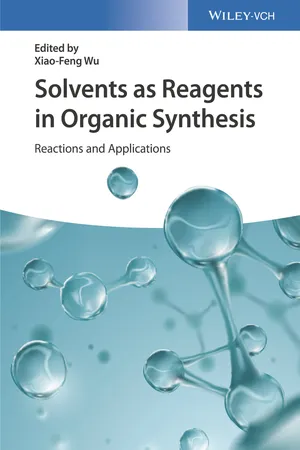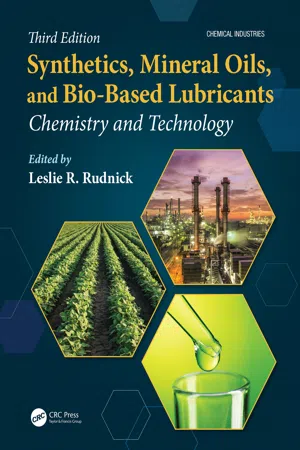Chemistry
Esterification
Esterification is a chemical reaction in which an alcohol and a carboxylic acid react to form an ester and water. This process typically requires the presence of an acid catalyst, such as sulfuric acid. Esterification is commonly used in the production of fragrances, flavorings, and as a method for synthesizing organic compounds.
Written by Perlego with AI-assistance
Related key terms
Related key terms
1 of 4
Related key terms
1 of 3
4 Key excerpts on "Esterification"
- eBook - ePub
Solvents as Reagents in Organic Synthesis
Reactions and Applications
- Xiao-Feng Wu(Author)
- 2017(Publication Date)
- Wiley-VCH(Publisher)
In 1940, Norton et al. [8] investigated the mechanism of Esterification between alcohol and strong carboxylic acid, revealing that the generated water was composed of the hydrogen from the alcohol and the hydroxyl from the acid. Since then, Esterification was deeply investigated and developed not only in the field of basic research but also in the industrialized mass production. However, the inherent attribute of the reaction between alcohol and carboxylic acid lie in its reversibility, which makes the reaction require the use of excess amount of one starting material or the addition of one dehydration reagent. Recently, Yamamoto et al. [9] achieved a breakthrough in this topic. With hafnium (IV) salts, such as hafnium (IV) chloride and hafnium (IV) tert -butoxide, as catalyst, the direct condensation of carboxylic acids and alcohols could be achieved in an equimolar amount. Subsequently, this method was applied to direct polyEsterification and large-scale operations. Following that, all kinds of homogeneous catalysts, such as Brønsted acids, Lewis acids, were developed [10]. In addition, ionic liquids [11] (ILs), one of the most promising new reaction mediums and catalysts, have been introduced to homogeneous catalysis of Esterification between alcohols and carboxylic acids. Meanwhile, solid-like non-volatile Brønsted acids have the advantages of motility, greater effective surface area, and potential activity in liquid phase. Combining sthese characteristics, Forbes and Davis et al. [12] first designed novel Brønsted acidic ILs containing an alkane sulfonic acid group and applied to Esterification between alcohol and carboxylic acids, which provided good product selectivities as well as a balance between a homogeneous acid catalyst and heterogeneous catalyst (ease catalyst/substrate separation) - eBook - ePub
Synthetics, Mineral Oils, and Bio-Based Lubricants
Chemistry and Technology
- Leslie R. Rudnick, Leslie R. Rudnick(Authors)
- 2020(Publication Date)
- CRC Press(Publisher)
- 1. Esterification
- 2. Stripping of excess reactants
- 3. Neutralization
- 4. Filtration
The basic chemical reaction for the Esterification process is shown in Figure 3.1 . Esterification is an equilibrium process, and formation of the ester group is carried out by mixing the acid and alcohol raw material while removing the water of reaction in order to drive the equilibrium to the right-hand side. Ester lubricant basefluids are normally manufactured batchwise, using a stirred reaction vessel equipped with heating, cooling, and overheads capable of condensing and separating water of reaction from volatile organic reactants by fractionation or decantation [13 ].To facilitate removal of water and accelerate reaction, Esterification processes are normally carried out at a temperature of at least 100°C, and since the products have good thermal stability, higher temperatures up to about 250°C are commonly used. Esterification catalysts may be used; these include strong mineral acids such as sulfuric or p-toluene sulfonic acids for use at lower temperatures and Lewis acid catalysts such as tin and titanium alcoholates at higher temperatures. Azeotroping agents may also be used to assist in removal of water [13 ].For diester products, the monoalcohol reactants normally have significant volatility, and a 10%–20% molar excess of monoalcohol is frequently used to drive the equilibrium. At the end of reaction, excess volatile reactant is removed by stripping under reduced pressure and recycled to subsequent batches.Similarly, for polyol esters, excess monoacid reactant may be used and stripped at the end of reaction. Because the excess acid serves to catalyze the reaction, polyol esters are frequently manufactured without use of additional catalyst.The Esterification and stripping process will typically give a conversion of acid groups of >99% in the crude reaction product. However, because very low acid values are generally required for lubricant basefluids, further reduction of acid concentration is frequently necessary. This can be achieved by treatment of the crude reaction product by addition of a base such as sodium carbonate or calcium hydroxide, which converts residual acid to carboxylate soaps that can be removed by water washing and/or filtration. - eBook - ePub
- (Author)
- 2009(Publication Date)
- Academic Press(Publisher)
The recent discovery of chloroformate-induced Esterification of carboxylic acids is a good example of this. Over time, many derivatization methods have become more or less obsolete as their original usefulness was determined by a lack of alternative methods for the determination of minute amounts of some analytes, especially those in biological fluids. Until the discovery of immunoassay (radioimmunoassay, RIA, and enzyme immunoassay, EIA) and the development of specific and sensitive HPLC detectors, the electron-capture detector (ECD) in GC was the only way to reach picomole concentration levels. At that time, therefore, there was considerable interest in the conversion of analytes into perhalo-genated products with a correspondingly high ECD response. Some of these methods or principles still persist; others do not. A comprehensive list of various chemical treatments can be found in the Handbook of Derivatives for Chromatography by Blau and Halket (see Further Reading). Some of the older useful methods and recent novel discoveries will be discussed in more detail below (see also the reviews by Hušek and Wells listed in the Further Reading section). Esterification Carboxylic acid groups usually require treatment with a group-oriented reagent that will not react in most cases with any other protonic groups that may be present. The choice of treatment depends on what class of acidic compounds – with or without extra reactive groups in the molecule – is to be esterified and what kind of detection (ECD or flame ionization detection, FID) is required. Esterification with Acidified Alcohols For analytical work, Esterification with methanol through to isoamyl alcohol is best done in the presence of a volatile catalyst such as hydrogen chloride, thionyl chloride or acetyl chloride, which can be readily removed together with any excess alcohol - eBook - ePub
- Raymond D. Harbison, Marie M. Bourgeois, Giffe T. Johnson(Authors)
- 2015(Publication Date)
- Wiley(Publisher)
57 Esters Raymond D. Harbison and C. Clifford ConawayEsters are compounds that result from the reaction of an alcohol or phenol with acids or derivatives of acids. Almost all the aliphatic esters are prepared by the reaction between carboxylic acids and alcohols. The subclasses of esters presented in this chapter include the aliphatic esters, halogenated acid esters, alkyl esters of sulfuric acid, important phosphate esters, nitrate esters, and esters of phthalic acid. Some esters, such as aliphatics esters, may present human health hazards (USEPA, 2007), if exposure occurs via the respiratory or dermal routes.Many organic esters are used extensively in the plastic industry, either as resins or as plasticizers, and as solvents for lacquers. The group of esters, including succinate, adipate, azelate, sebacate, citrate, and phthalate is generally used as plasticizers. Esters of inorganic acids, such as esters of sulfuric acid and phosphate esters, may have prominent corrosive or pharmacological properties. See Table 57.1
Index pages curate the most relevant extracts from our library of academic textbooks. They’ve been created using an in-house natural language model (NLM), each adding context and meaning to key research topics.
Explore more topic indexes
Explore more topic indexes
1 of 6
Explore more topic indexes
1 of 4



